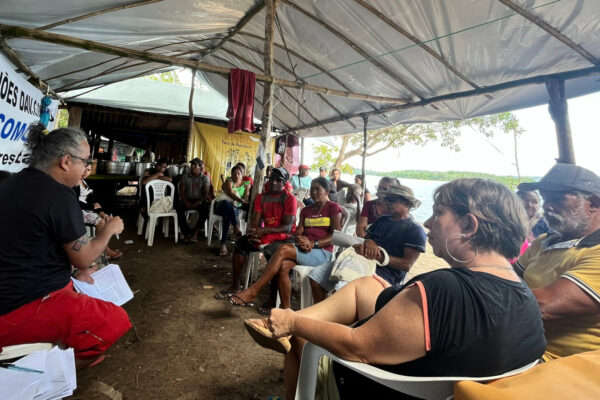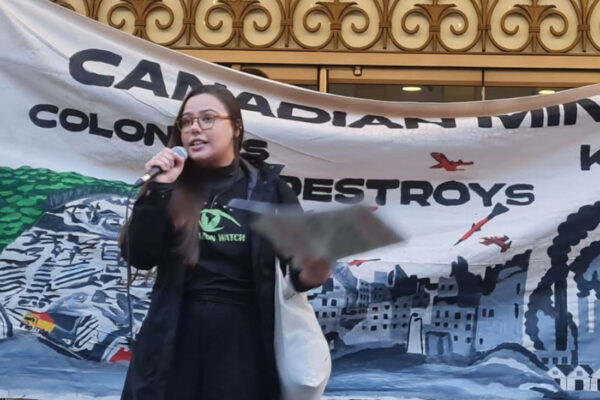Hi-res photos available here (© Ruy Sposati/CIMI)
Altamira, Brazil – Some 200 indigenous people affected by the construction of large hydroelectric dams in the Amazon launched an occupation today on one of the main construction sites of the Belo Monte dam complex on the Xingu River in the Brazilian Amazon. The group demands that the Brazilian government adopt effective legislation on prior consultations with indigenous peoples regarding projects that affect their lands and livelihoods. As this has not happened, they are demanding the immediate suspension of construction, technical studies and police operations related to dams along the Xingu, Tapajos and Teles Pires rivers. Shock troops of the military police were awaiting indigenous protestors when they arrived at the Belo Monte dam site, but they were unable to impede the occupation.
The indigenous protestors include members of the Juruna, Kayapó, Xipaya, Kuruaya, Asurini, Parakanã, Arara tribes from the Xingu River, as well as warriors of the Munduruku, a large tribe from the neighboring Tapajós river basin. The indigenous peoples are joined by fishermen and local riverine communities from the Xingu region. Initial reports indicate that approximately 6,000 workers at one of the main Belo Monte construction sites, Pimental, have ceased operations as a result of the protest. The occupation, according to the indigenous communities, will continue indefinitely or until the federal government meets their demands.
“Our forest and our river are one of the last natural heritages of Brazil. It’s sad to think: why are there so many dams planned on only one river?” Said Saw Exebu, spokesperson for the general chief of the Munduruku.”We don’t want this to happen on our lands. We don’t want dams built in our home, the Tapajós.”
Occupations against the Belo Monte dam complex and mobilizations against other Amazonian dams have become increasingly commonplace. Construction on Belo Monte has been halted on at least seven occasions over the last year due to the efforts of affected indigenous communities and fishermen to call attention to the failures of the Norte Energia dam building consortium and government agencies to comply with the project’s mandated environmental and social conditions. On March 21st, approximately 100 indigenous peoples, riverbank dwellers (ribeirinhos) and small farmers expelled dam workers and occupied the Pimental site, maintained by the Belo Monte Construction Consortium (CCBM). Additionally, recent strikes and protests by dam workers have created additional unrest at CCBM construction sites.
The Munduruku indigenous people and other local communities have mobilized against a cascade of over a dozen large dams slated for construction on the neighboring Tapajós river and its major tributaries, the Teles Pires, Juruena and Jamanxim. One of the first major dams under construction, UHE Teles Pires, has been the subject of lawsuits by Federal Public Prosecutors for lack of prior consultations with the Kayabi, Apiaká and Munduruku indigenous peoples. In recent weeks, the removal of funeral urns of the Munduruku people by dam contractors at the Sete Quedas rapids, considered a sacred site for indigenous tribes, provoked outrage.
Last March President Dilma Rousseff signed Decree no. 7957/2013 allowing the use of the National Guard and other armed forces to ensure that dam construction at places like Belo Monte and technical studies for planned Amazonian dams are not interrupted by indigenous protestors. In April, upon a request of the Ministry of Mines and Energy, approximately 250 federal and military police troops were dispatched to the Tapajós region to ensure continuation of technical studies for the first two large dams scheduled for construction, São Luiz do Tapajós and Jatobá. The military operation came in response to protests from the Munduruku people, whose traditional lands would be directly affected by the two large dams and who have suffered from a history of military operations on their lands.
“Today’s protest demonstrates the relentless resistance of a growing group of united peoples against Belo Monte, Tapajós and other destructive dams throughout the Amazon,” said Leila Salazar-Lopez, Amazon Watch Program Director. “These are the final moments to change course as construction closes in on the Xingu and other lifeline rivers of the Amazon.”
Official statement of the indigenous peoples of the Xingu and Tapajos (English translation)













